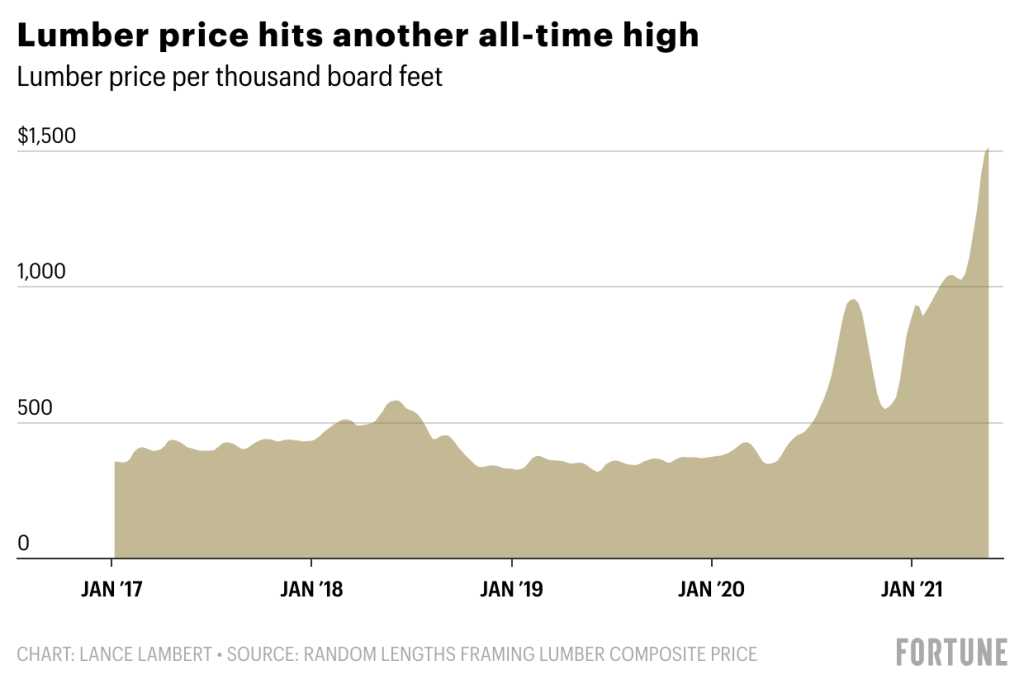如今,北美正在面临历史性的木材短缺危机。为此,房屋建筑商惴惴不安。因为担心无法购买到春夏项目所需的木材,他们花费数周时间,就木材期货展开了激烈的竞价。目前,这种疯狂的价格战似乎已经到头了:自5月10日以来,每千板英尺2×4英寸的7月期货合约价格从1,700美元以上跌至1,453美元。尽管这一价格仍然远远高于新冠肺炎疫情前的水平(当时的交易价格大多在300美元至500美元之间),但此次木材价格的回落依旧让许多业内人士相信,价格飙升的最糟糕时期已经过去。
但如果你指望家得宝(Home Depot)或劳氏公司(Lowe's)降价出售木材,那就大错特错了。虽然期货价格有所回落,但目前的“现货”价格(锯木厂向经销商和批发商收取的价格)刚刚创下历史新高。据全球木材产业调研机构Random Lengths的数据,5月21日,每千板英尺木材现货价格攀升至1,514美元,和2020年4月的价格相比,上涨幅度达到了令人震惊的323%。

“当前的木材期货价格有可能会让房屋建筑商在未来尽量少用木材。”Sherwood Lumber公司的首席执行官安迪•古德曼在接受《财富》杂志采访时表示。“‘未来’才是这句话的关键所在——7月期货合约是指当月装运、8月运抵经销商,之后再运抵零售商的散装木材——因此,此轮木材价格上涨的影响,至少要持续到下半年。”
专门研究木材价格的FastMarket RISI的高级经济学家达斯廷•贾尔伯特也认为,木材零售价格应该会很快下降一点,但他补充道:“这远没有达成协议。”虽然4月新开工率下降9%的迹象表明,一些建筑商最终因为木材价格过高而受到抑制,但需求仍然异常强劲。尽管上个月开盘有所下降,但自2006年年底以来,除了5个月外,它们仍然比其他所有的月都强劲。除非需求进一步回落,锯木厂仍然将继续努力与之相匹配。
正如《财富》杂志此前所解释的,这一历史性的木材短缺是由于新冠疫情期间引发的一场风暴所推动的。当新冠疫情在2020年春季爆发时,锯木厂由于担心即将来临的房屋市场崩盘而削减生产和减少库存。然而这次崩盘并没有发生,与之相反的情况却出现了。烦闷的、被隔离的美国人急忙赶到家得宝和劳氏公司购买自己动手项目的材料,而经济衰退引发的利率则有助于刺激房地产繁荣。由于大量千禧一代开始达到购房高峰,导致房屋库存枯竭,并让购房者寻找新建筑,这进一步加剧了此类繁荣景象。另外,因为家庭改造和建筑房屋需要大量木材,而锯木厂也无法跟上这种需求,因此产生了创纪录的价格。
目前,市场上存在的需求上升和供给受限情况仍然存在,而这也是价格调整可能依然需要数月才能够实现的原因。
古德曼在接受《财富》杂志采访时说:“由于需求被抑制、供应中断、工作场所的活动被推迟,所以我们看到项目将延长到今年夏季和秋季。这一供需缺口可能要到2021年年底或2022年年初才可以填补,这意味着在此之前,厂家大量的成本节约措施不会传导到消费者。”(财富中文网)
译者:郝秀
审校:汪皓
如今,北美正在面临历史性的木材短缺危机。为此,房屋建筑商惴惴不安。因为担心无法购买到春夏项目所需的木材,他们花费数周时间,就木材期货展开了激烈的竞价。目前,这种疯狂的价格战似乎已经到头了:自5月10日以来,每千板英尺2×4英寸的7月期货合约价格从1,700美元以上跌至1,453美元。尽管这一价格仍然远远高于新冠肺炎疫情前的水平(当时的交易价格大多在300美元至500美元之间),但此次木材价格的回落依旧让许多业内人士相信,价格飙升的最糟糕时期已经过去。
但如果你指望家得宝(Home Depot)或劳氏公司(Lowe's)降价出售木材,那就大错特错了。虽然期货价格有所回落,但目前的“现货”价格(锯木厂向经销商和批发商收取的价格)刚刚创下历史新高。据全球木材产业调研机构Random Lengths的数据,5月21日,每千板英尺木材现货价格攀升至1,514美元,和2020年4月的价格相比,上涨幅度达到了令人震惊的323%。
“当前的木材期货价格有可能会让房屋建筑商在未来尽量少用木材。”Sherwood Lumber公司的首席执行官安迪•古德曼在接受《财富》杂志采访时表示。“‘未来’才是这句话的关键所在——7月期货合约是指当月装运、8月运抵经销商,之后再运抵零售商的散装木材——因此,此轮木材价格上涨的影响,至少要持续到下半年。”
专门研究木材价格的FastMarket RISI的高级经济学家达斯廷•贾尔伯特也认为,木材零售价格应该会很快下降一点,但他补充道:“这远没有达成协议。”虽然4月新开工率下降9%的迹象表明,一些建筑商最终因为木材价格过高而受到抑制,但需求仍然异常强劲。尽管上个月开盘有所下降,但自2006年年底以来,除了5个月外,它们仍然比其他所有的月都强劲。除非需求进一步回落,锯木厂仍然将继续努力与之相匹配。
正如《财富》杂志此前所解释的,这一历史性的木材短缺是由于新冠疫情期间引发的一场风暴所推动的。当新冠疫情在2020年春季爆发时,锯木厂由于担心即将来临的房屋市场崩盘而削减生产和减少库存。然而这次崩盘并没有发生,与之相反的情况却出现了。烦闷的、被隔离的美国人急忙赶到家得宝和劳氏公司购买自己动手项目的材料,而经济衰退引发的利率则有助于刺激房地产繁荣。由于大量千禧一代开始达到购房高峰,导致房屋库存枯竭,并让购房者寻找新建筑,这进一步加剧了此类繁荣景象。另外,因为家庭改造和建筑房屋需要大量木材,而锯木厂也无法跟上这种需求,因此产生了创纪录的价格。
目前,市场上存在的需求上升和供给受限情况仍然存在,而这也是价格调整可能依然需要数月才能够实现的原因。
古德曼在接受《财富》杂志采访时说:“由于需求被抑制、供应中断、工作场所的活动被推迟,所以我们看到项目将延长到今年夏季和秋季。这一供需缺口可能要到2021年年底或2022年年初才可以填补,这意味着在此之前,厂家大量的成本节约措施不会传导到消费者。”(财富中文网)
译者:郝秀
审校:汪皓
We're amid a historic North American lumber shortage. It's why home builders, who are worried they won't get the materials they need for spring and summer projects, spent weeks engaging in a fierce bidding war over lumber futures. That frenzy seems to have reached its climax: Since May 10, the July futures contract price per thousand board feet of two-by-fours has fallen from over $1,700 to $1,453. While that's still well above pre-pandemic levels—when it typically traded in the $300 to $500 range—the pullback has many in the industry believing the worst of the price surges is over.
But don't expect to find a lumber discount in the aisles of Home Depot or Lowe's just yet. While the futures price has pulled back a bit, the current "cash" price (the price sawmills charge distributors and wholesalers) just hit a new all-time high. On May 21, the cash price per thousand board feet of lumber climbed to $1,514, according to industry trade publication Random Lengths. That's up a staggering 323% since April 2020.
"Lumber futures are indicating that potential savings could happen in the future," Andy Goodman, CEO of Sherwood Lumber, tells Fortune. "However, 'future' is the operative word. The July contract represents bulk lumber that ships in that month and arrives in August to the distributor and then the retailer."
Dustin Jalbert, a senior economist at Fastmarkets RISI where he specializes in wood prices, also thinks retail lumber prices should dip a bit soon, but adds, "It's far from a done deal." While April's 9% dip in new housing starts signaled that some builders are finally balking at exorbitant prices for lumber, demand remains incredibly strong. Even though starts were down last month, they're still stronger than all but five other months since the end of 2006. Unless demand pulls back further, sawmills will continue to struggle to match it.
As Fortune has previously explained, this historic lumber shortage was spurred by a perfect storm of factors set off during the pandemic. When COVID-19 broke out in spring 2020, sawmills cut production and unloaded inventory in fears of a looming housing crash. The crash didn't happen—instead, the opposite occurred. Bored, quarantining Americans rushed to Home Depot and Lowe’s to buy up materials for do-it-yourself projects, while recession-induced interest rates helped spur a housing boom. That boom, which was exacerbated by a large cohort of millennials starting to hit their peak home-buying years, dried up housing inventory and sent buyers in search of new construction. Home improvements and construction require a lot of lumber, and mills couldn't keep up. Cue record prices.
That elevated demand and constrained supply remain the reality. It's also why a price correction could take months to materialize.
"With the pent up demand, fractured supply, and delayed job site activity, we see projects extending deep into the summer and fall," Goodman tells Fortune. "This supply and demand gap likely will not be filled until late 2021 or early 2022, meaning that substantial cost savings will not trickle down to the consumer until then."






